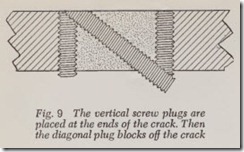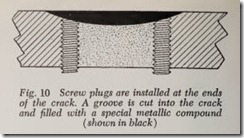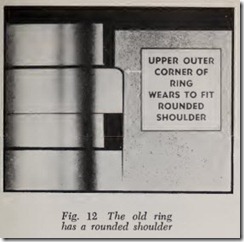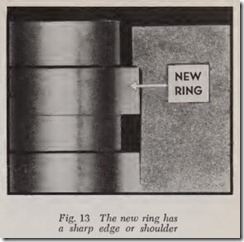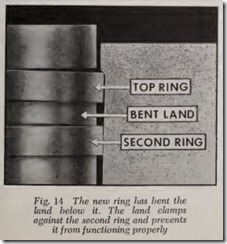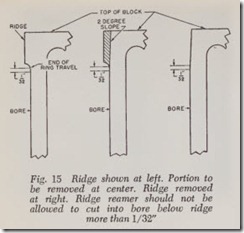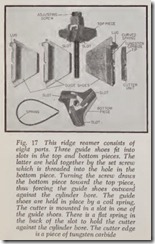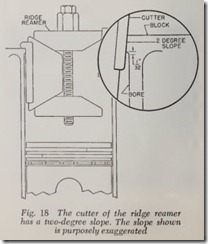Piston System Service
CHECKING FOR EXTERNAL OIL LOSS
Since an abnormal amount of oil may be leaving the engine in any one or any combination of ways, it is good practice to make a thorough examina tion of the engine before it is disassembled for repairs.
Dense, blue smoke coming from the exhaust while the engine is runing at a fast idle speed indicates that too much oil is being used.
Leaky gaskets, leaking metal-to-metal joints, leaky oil seals, or any other sources of oil leaving the crankcase should be located as definitely as possible, because after disassembly is once started, it is more difficult to locate such sources of trouble.
Fresh oil on the clutch housing, oil pan, fuel pump, edges of valve covers, external oil lines, distributor shaft housing, base of crankcase filler tube, or on the bottom of the timing case cover is a fairly good indication of an external leak close to that point.
The hole in a cylinder block at the rear end of the camshaft is sealed with either an expansion plug or a cover plate. Quite often oil leaking downward from this opening is found on the rear end of the oil pan or on the bottom of the clutch housing and is mistaken for a rear main bearing leak.
Any area underneath an engine that is washed clean with oil is an indication that there may be an external leak from the crankcase somewhere in front of the washed area. Oil blown or sucked from the crankcase through the crankcase ventilator outlet pipe generally produces washed areas on the ventilator side of the chassis.
If washed areas are found on the chassis behind the crankcase ventilator outlet, the ventilator inlet should be examined to see if it is clogged. Possibly the sheet metal surrounding the lower end of the ventilator outlet tube has been bent or the outlet tube has been moved out of line in such a way that the velocity of the air passing under the car at high speeds produces enough vacuum at the lower end of the ventilator outlet to suck the oil from the crankcase.
The crankcase ventilator outlet and inlet should be examined to see if they are partially or com pletely clogged, and are thus causing high crank case pressure to force oil out through joints that normally would not leak. The return passages in the valve cover plate between the crankcase ventilator outlet and the crankcase should be thor
oughly cleaned.
CHECKING FOR INTERNAL OIL LOSS
If the symptoms point to leaky rings, remove the spark plugs. If they are oily, the combustion chambers are receiving too much oil but do not forget that this may be due to: ( 1) Stuck rings which perhaps can be freed with a solvent. ( 2) A leaking vacuum pump diaphragm. ( 3) Leaky in take valve guides, or leaky intake and exhaust valve guides on overhead valve engines.
If blue smoke is seen at the exhaust, especially when the throttle is abruptly closed after deceler ating from speed the rings are either worn or stuck.
If spark plugs are wet after engine has been idling for ten minutes but are dry after a few miles of driving, the cause is probably leaky in take valve guides.
If spark plugs are wet after road driving, either the vacuum pump leaks or the rings leak due to wear or sticking. Be sure the screws on the vacuum diaphragm are tight before making this test.
A leaky vacuum pump diaphragm causes high oil consumption by permitting engine suction to draw oil vapor from the crankcase into the intake manifold, and thus it flows to the cylinders where it is burned. The arrow, Fig. 8, indicates the path of the oil particles through the leaky diaphragm. The suction of the engine pulls the oil through the holes in the diaphragm, through the open dis charge valve, then through the pipe leading to the intake manifold.
Whether the diaphragm leaks or not can readily be determined with a vacuum gauge. Disconnect the windshield wiper line at the vacuum pump and attach the vacuum gauge.
Start the engine and allow it to run for a few revolutions until the vacuum reading is a maxi mum. Shut off the engine. If the vacuum gauge needle remains stationary, there is no leakage. But if the needle starts moving toward zero, either the diaphragm leaks or the discharge valve leaks. To check for discharge valve leakage, start the en gine. When vacuum becomes a maximum discon nect the line to the intake manifold at the vacuum pump. Put your thumb over the hole in the pump. If the vacuum gauge needle falls, the diaphragm leaks. If it does not fall, the discharge valve leaks.
Worn main, rod or camshaft bearings cause increased oil consumption. The oil which escapes from these bearings is thrown in all directions by the whirling crankshaft and therefore an excess amount is tossed onto the cylinder walls. Some of this excess oil makes its way to the combustion chamber where it is burned.
Leakage of oil from the bearings causes a drop in oil pressure. (Chevrolet engines up to 1953 have splash feed to connecting rods.)
Therefore, when deciding whether or not a ring job is necessary it is important to know whether worn bearings are contributing to the high oil consumption. So be sure to check the oil pressure
-with the engine warm. If the oil pressure is 5 to 10 pounds below normal there is a good chance that bearings are worn. But do not forget that reduced oil pressure may be caused by various other troubles.
Whether or not the oil pressure is low, it is a good plan to check bearing leakage with an oil leak detector, as explained in the Engine Bearing System Chapter.
CYLINDER BLOCK INSPECTION
Before doing any work on rings, pistons, etc., it is advisable to inspect the block for defects.
Examine cylinder bores, top of block, valve seats and water jackets for cracks. Do not over look the inside of the valve lifter chamber. If cracks are not large enough to be seen they may be revealed by wet or rusted areas.
A minute crack not visible to the naked eye may be detected by coating the suspected area with a mixture of 25% kerosene and 75% light engine oil. Mix up some zinc oxide in wood alcohol to form a thin, white “paint.” Apply a coat to the surface. If there is a crack, the zinc oxide will be discolored. Note that there are several liquids on the market for detecting cracks.
Pressure testing the block will usually indicate the presence of a crack. Use 30 to 60 pounds water pressure or air with water. This test must be made with cylinder head installed unless dummy heads are available.
REPAIRING CRACKED BLOCKS
Repairing external cracks in cylinder blocks is readily accomplished by welding. But repairing internal cracks is quite an uncommon operation nowadays. It is discussed here merely to acquaint the reader with the methods used, especially dur ing World War II when new blocks were hard to come by.
Three methods of repairing internal cracks were used: by applying a metallic sealing compound; by the insertion of screw plugs, and by electric arc welding.
Metallic Sealing Compound-A can of this compound is poured into the radiator. It will successfully seal cracks which are not too large. Run the engine at a fast idle until thoroughly warm. This will require 15 to 30 minutes depend ing on how cold the engine was to begin with and whether the air temperature is high or low. It is a good idea to clean the cooling system with a cleaning compound before starting this work be cause the metallic sealer adheres better to clean cracks.
Screw Plugs-Specially made taper plugs of cast iron are available in various diameters. Plugs are installed at the ends of the crack. If the crack is more than 4″ long, install additional plugs approximately %” apart. The tension created by the plugs prevent the opening and closing of the crack under heat. The cracks remaining between the plugs can be closed by peening or the use of a metallic sealing compound or both. There are pneumatic peening hamm ers made for this work. Cut off the plugs with a cold chisel and smooth with a file or use the rotary files which are de signed for use with a )4″ electric drill. All types of cracks including cracked valve seats can be re paired by this method. The plug manufacturer’s instructions should be carefully followed in all cases.
Fig. 9 shows how these plugs are used. Holes are first drilled at the ends of the crack to prevent it from increasing in length. The holes then are threaded, plugs inserted and filed off flush with the surface. Then a diagonal hole is drilled, a plug inserted and filed off flush. This plug completely blocks the crack.
In Fig. 10, the crack is sealed with a special metallic compound. Holes are drilled at the ends to the crack and screw plugs inserted. A groove is cut into the crack as shown in black. Then the groove is filled with a special metallic compound.
Figs. 9 and 10 merely show the principles used in mending cracks with screw plugs. There is an infinite variety of ways th at plugs can be used for fixing various types of cracks including cracked valve seats. Therefore an instruction book sup plied by a manufacturer of the equipment needed for the work is essential.
Electric Arc Welding-Cracks may be welded after being suitably grooved. An arc welding machine is required.
Piston Ring Service
DISASSEMBLE ENGINE FOR RING JOB
In order to remove the piston and rod assem blies, it is necessary that both the cylinder head and oil pan be removed. The head must be taken. off because the piston assemblies must be re moved through the top of the block because there is not enough room in the crankshaft area to permit the removal of pistons from below. (The procedure for removing cylinder heads is covered in detail in the Engine Valve System chapter.)
RING RIDGE, REMOVE
Before removing the pistons, examine the bores for ridges, Fig. 11. The top ring on the piston is usually poorly lubricated because it is exposed to the extremely hot, high-pressure combustion gases which blow or boil the oil off of it. Therefore cylinder bore wear is greatest at the upper end of the top ring travel. The worn bore leaves a “ridge” above the ring. Unless this ridge is negligible, it should be cut away before the piston can be pushed out. If a ridge can be felt by rubbing the finger nail over the bore, it must be removed to avoid damage to new rings.
An attempt to force the piston up out of the bore may cause the ridge to bend or break the ring land just below the top ring.
Note also that even if the piston is coaxed past the ridge without suffering damage, it is still necessary to cut away the ridge if new rings are installed. In explanation, note that the old top ring has a rounded upper edge, Fig. 12, which has worn itself into the ridge. When a new ring is installed with a sharp edge, Fig. 13, the edge will strike the ridge and may bend the land, Fig. 14, so that the second ring is clamped tight in its groove and therefore cannot function. A clicking sound will be heard when the ring strikes the ridge. The ridge is cut away by means of a special tool called a ridge reamer.
Use of Ridge Reamer
There are a number of ridge reamers commer cially available and the manufacturer’s instruc tions should be carefully followed. But regardless of what make is used, it must be correctly in stalled in the bore and the cutting edge must be adjusted to the surface of the ridge. Care must be exercised not to allow the reamer to cut down into the bore below ridge more than 1/32″, as shown in Fig. 15. Cutting too far down into the bore will prevent the top ring from functioning properly and will greatly shorten its life.
Fig. 16 shows a typical ridge reamer installed in a bore, ready to remove the ridge. Fig. 17 explains its construction and principle of operation and tells you the names of its parts.
The edge of the cutter on all ridge reamers stands at a small angle to the bore, usually about two degrees, Fig. 18. Therefore it cuts a slightly tapered hole which blends smoothly with the bore.
To remove the ridge, proceed as follows:
1. Clean the top of the block.
2. Rotate the crankshaft to move the piston down to lower dead center. Wipe the bore with a clean rag wet with oil. Place a cloth over the piston to catch the cuttings from the ridge reamer. (After the ridge has been removed, turn the crank shaft half a revolution to bring the piston up to the top of the block, and remove the cloth with the cuttings.)
3. Lubricate the cutter with a few drops of oil. The maker recommends using a special oil.
4. Install the reamer in the bore as shown.
5. Expand the guide shoes by turning the hexhead screw at the top until it is finger tight.
6. Then turn the hex head turn to adjust the tension of the cutter.
7. Use a socket wrench to turn the cutter clockwise only. If cylinder head studs are in the way use a deep socket. Press down firmly on the wrench with the left hand while turning it with th·e right. While removing the ridge inspect the progress frequently. This can be done without removing the reamer from the bore.
8. Turn the hex head screw counter-clock-wise to remove the pressure on the shoes and lift the reamer out of the bore.
Remove Pistons and Rods
Before removing th e eonneeting rod eaps, note whether th e rods and caps are numbered to in dicate the cylinder to which they are fitted, Fig.19. Also note on which side of the engine the numbers are plaeed. On In-Line engines, the num bers are usually on th e eamshaft side of the engine. On V8 engines there is no set rule as to whieh side th e numb ers are placed so be sure to note th e location of th e numbers before taking out the pistons and rods.
If the rods are not numbered, identify themwith puneh marks. Used pistons and rod bearings work best in th eir original cylinders because pis tons eonform to the wear pattern of the bores and rod bearings do likewise on the erankshaft.
Nev er number a rod with file marks. A file mark may start a erack whieh will eventually cause the rod to break.
In all engines with four or more cylinders, the rods move up and down in pairs. Therefore it is eonvenient to r emove them in pairs. Rotate the crankshaft until a pair of rod caps are in the most eonvenient position for removal of rod bolt nuts. Remov e th e nuts and take off the caps.
Push th e two piston s up th rough and out of the bores. Be careful th e r ods do not serateh or niek the eranksh aft journ als. To avoid this, plastie sleeves may be used over th e rod bolts to proteet th e erankshaft as th e rod is pushed up into the eylind er.
Rotate the crankshaft to bring two more rods in position. Remove them, and continue in this man ner until all pistons and rods are removed.
On Corvair engines, the eomplete assembly of eylinder, piston and rod is removed as a unit; this is done when the engine is out of the car.

